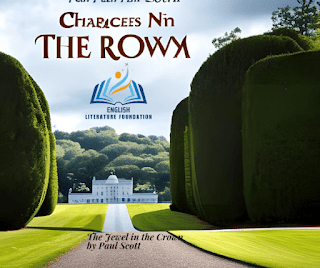Summary of the Novel "The Jewel in the Crown" by Paul Scott
Introduction
In this article, we will delve into the captivating world of Paul Scott's novel, "The Jewel in the Crown." This remarkable literary work takes us on a journey through the final years of British colonial rule in India, exploring themes of love, power, identity, and the impact of historical events on individual lives. Join us as we navigate the intricate web of characters and events that make up this enthralling tale.
Summary of the Novel "The Jewel in the Crown" by Paul Scott
At its core, "The Jewel in the Crown" revolves around the story of Daphne Manners, an Englishwoman who falls in love with an Indian man named Hari Kumar. Set against the backdrop of World War II and the growing Indian independence movement, their forbidden romance becomes a microcosm of the tensions and conflicts present in British-occupied India.
The novel introduces us to a diverse range of characters, each with their own motivations and struggles. We encounter Ronald Merrick, a British police officer who harbors deep-seated prejudices and becomes obsessed with maintaining the status quo. Then there's Ronald's sister, Susan, who seeks solace in religion but finds herself torn between her loyalty to her brother and her growing fondness for Daphne.
As the narrative progresses, the intricate layers of the story unfold, intertwining the lives of these characters and revealing the complex dynamics of power and colonialism. The novel skillfully explores the clash between cultures, the weight of societal expectations, and the indomitable human spirit in the face of adversity.
The Historical Context
To truly appreciate the depth of "The Jewel in the Crown," it is essential to understand the historical context in which it is set. The novel takes place during the final years of British colonial rule in India, a time when the Indian independence movement was gaining momentum. The tensions between the British occupiers and the Indian population serve as a constant backdrop, permeating every aspect of the story.
The author, Paul Scott, masterfully weaves historical events into the narrative, providing readers with a nuanced understanding of the complexities of the time. From the Quit India movement to the brutal realities of the Partition, the novel captures the essence of a nation on the brink of profound change.
The Themes Explored
"The Jewel in the Crown" touches upon several significant themes that resonate with readers to this day. Let's explore some of these themes:
1. Love Across Boundaries
The forbidden love between Daphne Manners and Hari Kumar is a central theme of the novel. Their relationship defies societal norms and challenges the deeply ingrained prejudices of the time. Through their story, Scott examines the power of love to transcend cultural and racial boundaries.
2. Identity and Belonging
The characters in the novel struggle with questions of identity and belonging. Daphne, torn between her British heritage and her love for India, grapples with a sense of displacement. Similarly, Hari, who is of Indian descent but has spent much of his life in England, faces an ongoing struggle to reconcile his dual identity.
3. Power and Colonialism
"The Jewel in the Crown" delves into the dynamics of power and colonialism. The British Raj's control over India is depicted as a complex system of domination and submission, where individuals are forced to navigate the intricate web of power relations. Scott skillfully explores the psychological impact of colonial rule on both the colonizers and the colonized.
4. Cultural Clash
The collision of British and Indian cultures lies at the heart of the novel. The clash between these two worlds leads to misunderstandings, tensions, and ultimately, tragedy. Scott brilliantly captures the cultural nuances, language barriers, and differing perspectives that contribute to the intricate tapestry of the story.
5. Prejudice and Discrimination
Prejudice and discrimination are pervasive themes throughout the novel. The deeply ingrained prejudices of the British colonial rulers towards the Indian population are explored, as well as the prejudices within Indian society itself. Scott skillfully exposes the destructive impact of such biases on individuals and communities.
6. Historical Legacy
"The Jewel in the Crown" confronts the historical legacy of British colonial rule in India. The novel raises questions about the long-term consequences of imperialism, the scars it leaves behind, and the enduring struggles for independence, identity, and justice.
7. The Struggle for Independence
"The Jewel in the Crown" captures the simmering unrest and growing desire for independence among the Indian population. As the nationalist movement gains momentum, the characters find themselves caught in the crosscurrents of political upheaval. The novel presents the aspirations, sacrifices, and conflicts faced by those who yearn for a free India, weaving a tapestry of hope and despair against the backdrop of historical events.
8. The Impact of Betrayal
Betrayal serves as a recurring motif throughout the narrative, highlighting the fragility of trust and the consequences of deception. Characters in the novel grapple with personal betrayals, shifting allegiances, and the betrayal of larger ideals. As secrets come to light and loyalties are tested, the true nature of individuals is revealed, leaving a lasting impact on the lives of those involved.
Frequently Asked Questions (FAQs)
1. What is the significance of the title "The Jewel in the Crown"?
The title "The Jewel in the Crown" refers to the symbolic importance of India within the British Empire. India was considered the most valuable and prized possession, often referred to as the "jewel" in the imperial crown. The novel explores the power dynamics and complexities associated with this notion.
2. Is "The Jewel in the Crown" based on real events?
While "The Jewel in the Crown" is a work of fiction, it is heavily influenced by the historical context of British colonial rule in India during the early 20th century. The author, Paul Scott, meticulously researched the period and incorporated real events into the narrative to provide a sense of authenticity.
3. Can "The Jewel in the Crown" be read as a standalone novel?
Yes, "The Jewel in the Crown" can be enjoyed as a standalone novel. However, it is part of a larger tetralogy called "The Raj Quartet," which consists of four interconnected novels that delve further into the lives of the characters and explore the impact of British colonialism in India in greater depth.
4. Does "The Jewel in the Crown" provide a balanced portrayal of British and Indian characters?
Yes, one of the strengths of the novel is its ability to provide multi-dimensional and complex portrayals of both British and Indian characters. Scott presents a diverse range of perspectives, highlighting the flaws and virtues of individuals from different backgrounds, offering a nuanced and balanced view.
5. Is "The Jewel in the Crown" a difficult read for non-native English speakers?
While the novel possesses intricate themes and layers, Scott's writing style is accessible and engaging. Non-native English speakers may need to familiarize themselves with some historical and cultural references, but overall, the novel can be enjoyed by readers of various linguistic backgrounds.
6. What is the lasting impact of "The Jewel in the Crown"?
"The Jewel in the Crown" has left a lasting impact on the literary world, praised for its compelling storytelling, rich character development, and thought-provoking exploration of colonialism and its aftermath. It continues to be studied, celebrated, and cherished as a significant contribution to British and postcolonial literature.
7. What is the historical context of "The Jewel in the Crown"? "The Jewel in the Crown" is set during the final years of British rule in India, primarily in the 1940s. It explores the tensions and conflicts that marked this period of colonial history.
Conclusion
In conclusion, "The Jewel in the Crown" by Paul Scott is a captivating novel that takes readers on a profound journey through the final years of British colonial rule in India. With its exploration of love, power, identity, and the impact of historical events, the novel remains relevant and thought-provoking. It serves as a testament to the enduring power of literature to illuminate the complexities of the human experience.

